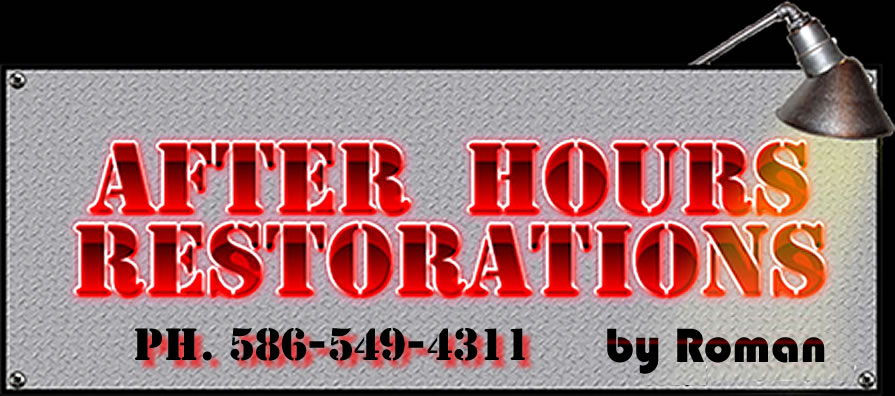In the late part of 1965, an
unknown person walked into Miami Valley Dodge in Dayton, OH and created this
beautiful 1966 Hemi Charger.
By simply
checking off boxes with a pen, they created one of only 250 Hemi 4 speed
Chargers that would be built in the 1966 model year.
Aside from the plush and detailed
interior that came standard on 1966 Chargers, this wolf in sheep’s clothing was
light in the options department...
a
heater and
AM radio covered them all.
Our unknown buyer went all out in
the drivetrain / suspension department though.
The Charger was optioned with the 426 Street Hemi, trak pak (18 spline
Hemi 4- speed, 3.54:1 Dana 60), HD drum brakes, maximum cooling package, and
the Hemi suspension package.
Fast forward to 2008, the Charger’s
past is virtually unknown.
It was
apparent that the years of use had left the Charger with bumps, bruises, and
battle scars, and in the mid 2000’s it was the victim of a poor quality
restoration.
The Charger was basically
fixed up in the cheapest way possible and sold for a profit.
In the fall of 2010, the Charger’s
luck had changed when Mopar collector Rich Warner found the car for sale.
Recognizing a diamond in the rough, Rich
decided to purchase it and add to his collection.
Rich is a dedicated Mopar fan that has
collected approximately 60 vehicles that range from a 1926 Dodge Brothers truck
to a modern Dodge Viper and about everything in between.
After owning the Charger for a few
weeks, Rich decided it was time to have the Hemi completely restored.
He shipped it to
After Hours Restorations near Detroit for a complete OE rotisserie
restoration.

In November of 2010, Roman at
After Hours Restorations began the
process. The Charger was completely
stripped down to a bare shell and sent out to be media blasted. Once the body returned, it was apparent that
both quarter panels needed to be replaced.
This was a huge issue since 66-67
Charger quarter panels are not being reproduced.
Embarking on an intense quest for anything
good enough to be used, both quarter panels were finally procurred from two
separate donor cars.
The quarter dilemma
did not end there.
Since both
replacement quarters were 44 years old, they too needed repair before they
could be installed.
The front fenders where also
replaced with a rust free pair.
Both
doors required lower patches and the center of the trunk pan was replaced.
After the metal work was completed, the body
was taken to the body shop for paint work.
While the paint department was
doing its thing, it was time to concentrate on restoring all of the components
of the Charger.
Fortunately, and which
doesn’t happen all that often, this was a no expense spared restoration.
For those people who are familiar with first
generation Chargers, they can relate to the amount of money it requires to
properly restore this car.
Tackling the interior was one of
the most difficult tasks of this restoration.
First generation Chargers have one of the most beautiful interiors of
all old mopars.
This Charger is loaded
with stainless steel trim and chrome throughout that required all to be
professionally restored and plated.


The
gauge cluster and the electro-luminescence lighting system were completely
restored. This gauge cluster is
absolutely stunning when viewed at night.
All of the interior panels were professionally recovered and reassembled
with new aluminum trim and restored chrome/stainless with Legendary
materials. No details were left out
resulting in a breathtaking interior.
The gauge cluster and the electro-luminescence lighting
system were completely restored. This
gauge cluster is absolutely stunning when viewed at night. All of the interior panels were professionally
recovered and reassembled with new aluminum trim from Winslow Motorsports. And of course, Legendary seat covers were
used to bring back the unique four bucket seat arraignment to its former glory. No details were left out resulting in a
breathtaking interior.
The drivetrain was also completely
rebuilt.
The Hemi was bored .030 over
and fitted with new Keith Black pistons.
A stock Mopar Performance Street Hemi replacement cam was used as
well.
The
carburetors
were both restored to stock specs and sit on top of the correct dual quad
intake manifold.
Stock exhaust manifolds were used
with a stock Hemi exhaust system.
Since
this was an OE style restoration, the Charger was converted back to the factory
direct drive starter system.
This
required specific parts like the flywheel, bell housing, throw out bearing, and
starter to be located. (Many times we see cars converted to the later 10.5
clutch/bellhousing so the more reliable, interchangeable and plentiful gear
reduction starter can be used.)
The original Dana 60 was completely
torn down, stripped, cleaned, painted and reassembled.
Special attention was given to details like
phosphate coating the backing plates, and nickel plating the pinion yoke dust
shield.
The Charger returned from the body shop
finding all of its original counterparts restored and waiting assembly.
At this point
After Hours Restorations was under the Gun.
The Charger was only a few short weeks away
from making its debut at the Muscle Cars show in Beverly Hills, CA.
Several intense and long nights
later, this pristine beauty was meticulously reassembled even better than the
factory did it in the winter of 1965.
The impending Hollwood show debut was not the only cause of stress at
the shop… more importantly, the Charger had to be ready to impress Rich who had
not seen his car since the day he dropped it off eleven months prior.
If done right, the reactions from
the owners of restored cars always makes the long hours and hard work well
worth the effort. You cannot put a value
on the smile Rich had on his face when he first laid eyes on his beautifully
restored Hemi Charger …
After Hours
does it right!











.jpg)











